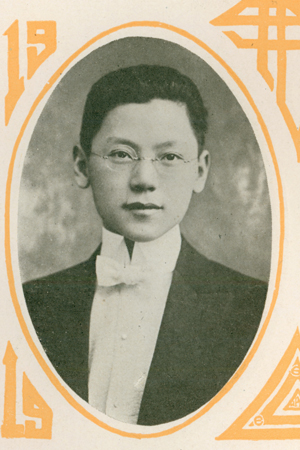AAPI and Latinx at UMD
We Here!
Latinx and APIDA Demands for Recognition
Being viewed as fully participating citizens in the United States has been a source of tension for historically marginalized communities, including Asian Pacific Islander Desi Americans (APIDA). In 1982, Asian Americans banded together in what is considered one of the largest Pan-Asian protests after the murder of Vincent Chin, a Chinese American killed in Detroit in the midst of increased tensions between the U.S. and Japanese auto industries.

C.C. Chen. Reveille, 1918. University Publications collection.
Within higher education, colleges and universities were not immune to calls for equitable treatment of the APIDA student population. Groups like the Alliance for Asian American Concerns and the Asian American Student Association were established across the country, demanding cultural centers on campuses. Students at the University of Maryland (UMD) organized to establish visibility both within and outside their classrooms. In 1991, UMD’s Asian Student Union demanded the creation of an Asian American Studies program and established various student publications. These student newspapers provided a platform to build their community, share their culture, express their views on international affairs, or bring attention to Anti-Asian violence.
The Chicano Movement, also known as El Movimiento from 1965-1975, is viewed as the longest civil rights movement of Mexican American descendants in the United States. The goal was for the community to control its resources and determine its future. It called for community control of its schools, economy, politics, and culture. Areas such as Washington D.C established the first Latino Festival in Kalorama Park, a celebration of Latino heritage drawing hundreds and eventually thousands of attendees. Garry Garber, a UMD alumnus, famed bantamweight boxer, and Hall of Fame inductee, became one of the founders of the Latin American Youth Center (LAYC).
The 1960s and 1970s brought about changing demographics in places like Columbia Heights, NY, and Baltimore, MD, as youth from the Caribbean and Central and South America became part of schools, neighborhoods, and other social spaces. As a result of these changes, the 1980s and 1990s at UMD proved to be some of the most consequential decades in campus history, with students rallying for courses celebrating stories of the Latinx community.
La Voz Latina, an independent student newspaper was created during this time. The paper engaged in discourse around civil rights abuses and pushed for social and political engagement by covering cultural events, local and international affairs, and student organizations such as the Hispanic Student Union and the Upsilon Chapter of Lambda Theta Alpha Latin Sorority.
Timeline
-
1987
The Hispanic Student Union and La Voz Latina are established on campus.
-
1991
The Asian Student Union (ASU) is established to serve as the voice for Asian students on campus and to aid communication between Asian minority groups.
-
1992
During Homecoming, students from the Asian Culture Club face harassment, including racial slurs. Members of the ASU demand a meeting between the representatives from various student groups and campus administrative offices.
-
1994
La Voz Latina uses a story of the 1991 riots in Mt. Pleasant following the police shooting of an El Salvadoran man to encourage Latino students to become more involved in voting and local politics.
The Upsilon Chapter of Lambda Theta Alpha Latin Sorority is established.
-
1998
Students advocate for courses examining the evolution of the Asian American community and propose a 21-credit Asian American Studies certificate or minor degree program.

